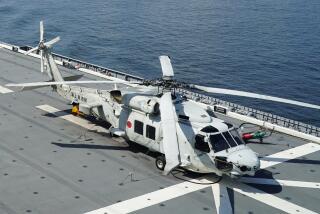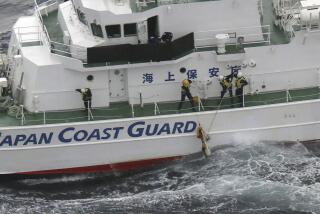Sub Hit Boat During Emergency Drill
- Share via
PEARL HARBOR, Hawaii — The nuclear-powered U.S. submarine that struck a Japanese fishing vessel filled with teenagers was apparently conducting an emergency surfacing exercise in choppy waters, Navy officials said Saturday. Details of the accident, however, remain unclear.
The attack submarine Greeneville, which sustained a long orange scrape across its hull when it sunk the much smaller Japanese boat Friday, glided silently into port under cloudy skies after spending the night aiding in the search for nine people missing from the Ehime Maru--four students, two teachers and three crew members.
As the Coast Guard and Navy widened their search Saturday to a 1,450-square-mile swath of ocean south of Diamond Head, the submarine’s captain, Cmdr. Scott Waddle of Austin, Texas, was reassigned to a desk job pending completion of an investigation into the tragedy.
The Greeneville crew was joined by 15 civilians and a high-level Pacific Fleet submarine officer for the annual emergency exercise, during which the submarine rockets through the ocean’s surface. The Ehime Maru was split open and sank within 10 minutes in 77-degree water nine to 12 miles off the Hawaii coast.
“There have been no signs of [the missing], however we are holding out hope that they are still alive,” said Lt. Greg Fondran, public affairs officer for the 14th Coast Guard District. “We’re still searching, and we’re doing the best we can. It’s fairly warm water, but over time, hypothermia is a possibility.”
President Bush sent his condolences to Japan on Saturday through Secretary of State Colin L. Powell, who telephoned Japanese Foreign Minister Yohei Kono “and expressed regret and apology,” said State Department spokesman David Denny in Washington.
Meanwhile, the National Transportation Safety Board, an independent government body, said it had sent a five-member rapid response team to investigate the collision. The agency has jurisdiction because the accident occurred in U.S. waters and involved a private vessel.
The Greeneville, one of the Navy’s newest and most high-tech submarines, was on a routine one-day training mission when it struck the 191-foot Ehime Maru. The Coast Guard received a distress beacon from the Japanese boat, as well as an emergency signal from the submarine, about 2 p.m. Hawaii Standard Time.
Rescuers arrived on the scene 25 minutes later and picked up 26 survivors from lifeboats surrounded by debris and diesel fuel. A dozen were taken to hospitals for treatment of minor injuries; only one survivor remained hospitalized Saturday.
Coast Guard Chief Petty Officer Robert Schmidt, who was on the first rescue ship to arrive at the scene Friday, said the area was slick with fuel and littered with fishing floats and pieces of wood from the steel-hulled boat.
Silent with shock and seasickness, the soaking wet survivors clung to eight life rafts, three of them lashed together, Schmidt said. The rescue was made more difficult by the 4- to 6-foot seas, punctuated by occasional 8-foot swells.
Communication was hit and miss; the students, teachers and crew spoke mostly Japanese. “When I was trying to verify with the captain how many people he had aboard, we played charades there a little bit, until I was actually positive that he had 35,” Schmidt said.
Coast Guard members who went from raft to raft found one man with a broken collarbone and others who had ingested diesel fuel. The boat sank fast, and “there wasn’t a life jacket to be seen,” Schmidt said.
Hisao Onishi, captain of the Japanese trawler, described the collision as sudden and noisy. He said it felt as if he had run the Ehime Maru “over some kind of a big building.”
Speaking in his native tongue Saturday evening during a news conference at the Japanese Cultural Center in Honolulu, Onishi said: “The ship didn’t even tilt. It just went directly down, sinking. . . . I felt like it took less than five minutes.”
Trying to explain Saturday evening what it was like to bob in the Pacific waiting for rescue, Onishi broke into sobs and covered his eyes with a handkerchief.
When the submarine hit the trawler, the crew and students had finished lunch. Some of the teenagers were cleaning up after the meal and others were relaxing in their quarters, the captain said.
Atsushi Kamado, a 16-year-old survivor who was studying engineering on the Ehime Maru, told the Honolulu Star-Bulletin through a translator that he was “in a panic” when the submarine struck.
“We had believed the boat was completely safe and never thought it would sink,” he said.
Kamado said he was on the second level from the bottom of the ship when the submarine hit. He heard a loud noise, and the lights went out. Smoke and oil poured in from the engine room, and the ship flooded with water.
With no time to grab a life jacket, he raced to the bridge. He said he hung on to the railing of the bridge but was sucked under the water as the ship went down. He was able to swim to a lifeboat on the surface.
“I want to tell my parents I am alive,” Kamado said.
Because of the swells, the Greeneville could not immediately open its hatches to take the survivors on board, Adm. Thomas Fargo, the senior naval officer in the Pacific, said at a news conference here.
Nonetheless, “the submarine was involved immediately in the rescue effort, providing the initial search and communication back to those on shore in Hawaii,” he said.
But late Saturday evening, Onishi challenged Fargo’s description of the submarine’s part in the rescue effort. He didn’t think the waves were too high, he said.
“I thought, ‘Why doesn’t the sub even have a rescue raft?’ ” Onishi recounted. “I thought that there would be a raft or safety equipment, however, nothing was done. They just watched us.”
Fargo said the submarine apparently was practicing an emergency surfacing maneuver when it struck the Ehime Maru, which carried students from a vocational high school in southwestern Japan, some of whom were training to be commercial fishermen.
In both normal and emergency surfacings, the submarine’s crew conducts a sonar scan and a visual check through the periscope before surfacing to make sure that the way is clear, submarine experts said.
But the emergency procedure is far faster than normal. After making the sonar and visual inspection, the submarine dives and then surfaces again quickly, said Lt. Cmdr. Dave Werner, public affairs officer for the commander of submarine forces in the Pacific.
The boat shoots toward the surface at a 30-degree angle, with crew members forced to hang on to fixtures to keep from toppling. “You really rocket up there,” said retired Vice Adm. Bernard Kauderer, former commander of submarines in the Atlantic and Pacific fleet.
The emergency drill, usually done once a year, was initiated after the Thresher disaster in 1963, when a crippled submarine found itself unable to surface.
The entire procedure, Kauderer said, should take only two minutes or less. If a careful search had been made with sonar and periscope, there should not have been enough time for a surface ship to enter the area.
“It is not yet clear how the accident occurred,” said Fargo, who visited the Japanese consulate in Honolulu on Saturday. “It is both tragic and regrettable. I would like to extend my apologies to all those involved, the families and the government of Japan.”
Equipment failures--or failure of the submarine crew to follow procedures--can result in collisions, Kauderer and other former submariners said Saturday as they puzzled over just what happened off the Hawaiian coast.
Sonar isn’t perfect and can fail to detect surface ships that are not running their engines. Sonar also has trouble detecting ships that are directly behind the submarine or directly approaching it.
A submarine captain, before surfacing, needs to reposition his vessel so that the sonar can sweep those “deaf” spots. Failure to do so can lead to a collision.
In addition, during a normal surfacing, if a captain spots a ship through his periscope, he has only a few seconds to respond to avoid a collision. Any pause in following the captain’s orders to take evasive action also can end in a collision.
In a 1989 collision between a surfacing submarine and a tugboat off Southern California, the captain was later criticized for not having turned the submarine so that the sonar could complete its sweep.
A retired Navy officer, who asked to remain unidentified, said he had never heard of a case similar to the Hawaiian accident during his career.
“This is amazing. It must have been really a freak thing,” the former officer said, noting that submarines follow procedures that never vary.
But Navy officials acknowledged that waves, fog and rain can sometimes make it hard to see and hear other vessels.
Norman Polmar, a naval analyst and author based in Alexandria, Va., said that the most likely reasons for the collision were either a deficient procedure for surfacing or, more probably, “someone did something wrong or didn’t do it well enough.”
Submarines only surface during exercises when they are about to enter port. A surfacing submarine normally relies on sonar to check for propeller noise. During daylight hours, the sub levels off at a specified depth to use its periscope to search the surrounding area, he said.
Retired Adm. Archie Clemins, a former submariner and commander of the U.S. Pacific Fleet, said it is possible that temperature changes in the water kept the Greeneville’s sonar from hearing noise from the Japanese trawler.
“The submarine quite easily could have used his sonar and done everything right but still heard nothing,” Clemins said, adding that the area off Diamond Head is known for choppy seas and is a fairly heavily traveled route for both military and civilian ships.
“Surfacing there is never, never a routine procedure,” he said.
Friday’s collision between the Greeneville and the Ehime Maru wasn’t the first such collision between a U.S. submarine and a Japanese ship. In fact, a similar 1981 crash in Japan could provide some clues to what happened off Diamond Head.
In April 1981, the Nissho Maru was struck by the George Washington in waters off Kagoshima Prefecture in southwestern Japan. Two crew members from the Japanese merchant ship were killed in the accident.
According to the final report on the accident, the George Washington, which was submerging as part of a joint military drill with anti-submarine aircraft, was aware the Nissho Maru was in the immediate area.
But even though a submarine crew member reported the ship’s presence to a supervisor and the supervisor then alerted a superior officer, somehow the superior officer did not take notice or confirm the presence of the Japanese cargo ship.
The submarine struck the Nissho Maru as its captain extended the periscope while diving deeper. The hull around the Nissho Maru’s engine room was punctured by the periscope, and the ship sank.
The investigative report concluded the primary causes of the collision were inadequate command and insufficient watch.
The George Washington left the scene after the collision without attempting to perform any type of rescue operation, which later created a serious political rift between Japan and the United States.
The U.S. military reprimanded the submarine’s crew, including stripping the captain of his rank, and paid the shipping company that owned the Nissho Maru 255 million yen in compensation.
After Friday’s incident, the Navy set up an assistance center at the Ala Moana Hotel in Honolulu to make sure the survivors have funds, that their other needs are met and that they can communicate with their loved ones. Family members are expected to arrive from Japan today, the Japanese consulate said.
The search will continue, said Coast Guard Chief Petty Officer Gary Openshaw, “until all chances of survival are exhausted.”
*
Times staff writer Maria L. La Ganga and special correspondent Susan Essoyan reported from Honolulu. Times staff writers Alan C. Miller and Paul Richter reported from Washington and Tony Perry from San Diego. Researcher Penny Love also contributed to this story.
(BEGIN TEXT OF INFOBOX / INFOGRAPHIC)
Procedure for Emergency Surfacing
Navy officials say the nuclear-powered Greeneville was practicing an emergency surfacing procedure at the time of the collision.
1. At 100 feet, submarine scans the area with sonar.
2. Submarine rises to depth of about 65 feet and raises periscope for 360-degree view.
3. Instead of surfacing, vessel lowers periscope and dives to about 600-800 feet. The submarine then uses air to push water out of the ballast tanks. Engines are set to full thrust.
4. Submarine shoots up towards the surface at an angle of about 30 degrees and a speed of about 25 knots (about 29 mph), exposing as much as 2/3 of the hull.
Sources: Jane’s Fighting Ships and U.S. Navy
More to Read
Sign up for Essential California
The most important California stories and recommendations in your inbox every morning.
You may occasionally receive promotional content from the Los Angeles Times.














